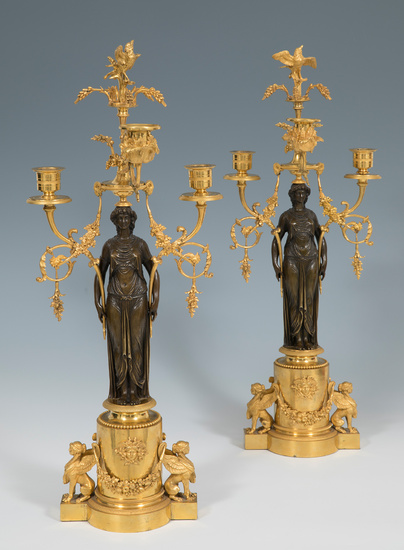Attributed to Francesco Righetti
Attributed to FRANCESCO RIGHETTI (Rome, 1749-1819); early 19th century.
"Candelabra".
Mercury gilded and blued bronze.
They have slight flaws and one of the candlesticks shows restoration in one of the lights.
Measurements: 62 x 23,5 x 15 cm (x2).
Pair of three lights candelabra made in mercury gilded bronze and burnished bronze. Both candelabra have the same structure and aesthetic conception, defined by a historicist design of classical inspiration, mainly inspired by the baroque of Louis XIV. Each of the pieces that make up this set consists of a round base with surface ornaments in the form of garland-like appliqués and rosettes. On the sides the base extends to support the figure of two sphinxes, one on each flank. This area is conceived as a pedestal to give way to the structure of the shaft. This has been designed in a sculptural way and represents the figure of a woman dressed in the classical manner holding the body of lights as if it were a caryatid. Finally, from the body of lights hang the ornamental motifs also made in bronze. This type of candelabra were very common in the I Empire and, being inspired by them, in the II French Empire. In both cases, the influence of classical decorative elements is clear, both in the reliefs and in the figures on the pedestals.
The style is largely reminiscent of some of the works of Francesco Righetti, Italian sculptor, silversmith and bronze worker. He quickly became the successor of his master Luigi Valadier, a prominent Roman silversmith who also produced copies after Antiquity, and responded with skill and energy to collectors' taste for faithful replicas of famous statues, both ancient and modern, and antiquarian ornaments. Righetti worked on large-scale projects for popes and monarchs, but he is best remembered for his small bronze statuettes of famous antiquities. In 1781, Righetti received his first known large-scale commission: 12 life-size lead casts of famous statues for the English banker Henry Hope at his country house in Welgelegen. During the 1780s, Righetti established himself as a producer of bronze miniatures from famous antique prototypes, a sculptural genre that developed in the second half of the 18th century in response to the burgeoning art market. His son Luigi ran the Neapolitan workshop in his absence and, after Righetti's death, Luigi and his son Francesco Righetti the Younger ran both the Neapolitan and Roman foundries.
COMMENTS
They present slight flaws and one of the candlesticks shows restoration in one of the lights.
This lot can be seen at the Setdart Madrid Gallery located at C/Velázquez, 7.
View it on
Estimate
Time, Location
Auction House
Attributed to FRANCESCO RIGHETTI (Rome, 1749-1819); early 19th century.
"Candelabra".
Mercury gilded and blued bronze.
They have slight flaws and one of the candlesticks shows restoration in one of the lights.
Measurements: 62 x 23,5 x 15 cm (x2).
Pair of three lights candelabra made in mercury gilded bronze and burnished bronze. Both candelabra have the same structure and aesthetic conception, defined by a historicist design of classical inspiration, mainly inspired by the baroque of Louis XIV. Each of the pieces that make up this set consists of a round base with surface ornaments in the form of garland-like appliqués and rosettes. On the sides the base extends to support the figure of two sphinxes, one on each flank. This area is conceived as a pedestal to give way to the structure of the shaft. This has been designed in a sculptural way and represents the figure of a woman dressed in the classical manner holding the body of lights as if it were a caryatid. Finally, from the body of lights hang the ornamental motifs also made in bronze. This type of candelabra were very common in the I Empire and, being inspired by them, in the II French Empire. In both cases, the influence of classical decorative elements is clear, both in the reliefs and in the figures on the pedestals.
The style is largely reminiscent of some of the works of Francesco Righetti, Italian sculptor, silversmith and bronze worker. He quickly became the successor of his master Luigi Valadier, a prominent Roman silversmith who also produced copies after Antiquity, and responded with skill and energy to collectors' taste for faithful replicas of famous statues, both ancient and modern, and antiquarian ornaments. Righetti worked on large-scale projects for popes and monarchs, but he is best remembered for his small bronze statuettes of famous antiquities. In 1781, Righetti received his first known large-scale commission: 12 life-size lead casts of famous statues for the English banker Henry Hope at his country house in Welgelegen. During the 1780s, Righetti established himself as a producer of bronze miniatures from famous antique prototypes, a sculptural genre that developed in the second half of the 18th century in response to the burgeoning art market. His son Luigi ran the Neapolitan workshop in his absence and, after Righetti's death, Luigi and his son Francesco Righetti the Younger ran both the Neapolitan and Roman foundries.
COMMENTS
They present slight flaws and one of the candlesticks shows restoration in one of the lights.
This lot can be seen at the Setdart Madrid Gallery located at C/Velázquez, 7.



